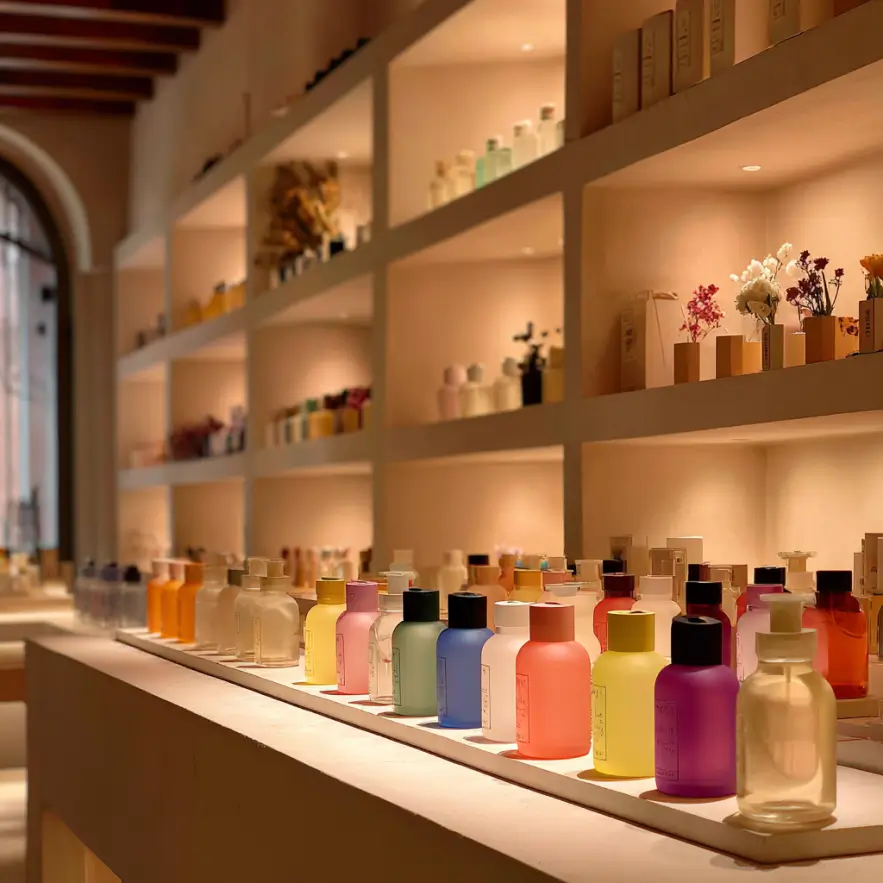When it comes to niche or artisanal perfumes, shoppers expect much more than just a bottle. What matters is the environment around them, how the space feels physically, and how it engages the senses. A perfume boutique becomes a place where fragrance is an event, and the buying process becomes a personal ritual. And now, this is all built on new principles of design, logistics, and customer experience.
Space as an extension of scent: a new approach to interior design
A modern perfume boutique is not just a shop filled with shelves of bottles. It’s fragrance scenography—a setting that reveals the essence of each scent through architectural and design decisions. Many brands have moved away from gold-accented opulence in favor of minimalism, soft lines, calm lighting, and textured materials.
One of the top requirements is eliminating unrelated odors. This applies to finishing materials and furniture surfaces. Boutiques now rely more on porcelain tiles, metal, glass, and polished concrete—all of which don’t absorb scents and are easy to clean. The interior becomes a neutral canvas that lets each perfume stand out.
Acoustics and soundscapes also play a major role. Soft background noise, no echo, and low-key music without aggressive beats enhance scent perception. Hearing and smell work together—if the space is noisy or the soundtrack is too intense, the fragrance is experienced differently.Design and atmosphere matter beyond niche retail. Discover how small urban retail formats are becoming anchors of comfort and flexibility in city life.
Navigation and customer flow: what truly matters
Buying a scent is rarely a linear process. A customer might walk in with a goal but stay for an hour, exploring flacons, testing novelties, chatting with a consultant. That’s why next-gen boutiques follow a scenario-based layout. It’s not a corridor; it’s a series of microzones: testing, conversation, packaging, and quiet spaces.
One popular concept is the open testing zone near the entrance. It’s not a counter or display, but an island with accessible scents, allowing guests to explore without staff pressure. Height matters here, as does warm light, paper blotters, and a disposal spot. This is where trust begins.
From there, the layout may guide visitors to a private testing area where they can sit and experience a scent quietly. Comfortable chairs, a mirror, and neutralizing wipes are common. This space doesn’t push the sale—it lets customers feel at ease. That’s key for complex, layered compositions that evolve on skin.The final moment—packaging—is equally intentional. More boutiques offer personalized wrapping: ribbon colors, custom cards, engraved flacons. This is the memory customers take with them, the closing note of the entire experience.
Materials that serve the concept
Designers increasingly focus on tactile, neutral finishes. Matte wood surfaces, natural stone, and microporous concrete reduce visual clutter and don’t compete with scent.
Glass displays aren’t about showcasing luxury—they help create depth and dimension. Light reflections, shadows, and glass combined with dark backdrops give the illusion that the perfume is floating. It’s visual poetry.
A popular design move is zoning with textiles and lighting instead of walls. This maintains openness while guiding flow. Velvet curtains might separate the wrapping area, and spotlighting draws focus to select product lines.Shelving systems deserve special attention. They no longer resemble standard retail racks but instead act as exhibition pieces. Asymmetry, a mix of open and closed niches, and integrated lighting make each bottle feel like an object of beauty, not just a product.
Comfort and care: building the customer journey
Staff now play a larger role. Today’s consultant is not just a salesperson but a guide to the world of scent. They read body language, ask intuitive questions, and make clients feel understood. Training goes beyond ingredients—it includes communication and emotional cues.
Boutique operations are changing too. More stores now work by appointment, offering one-on-one service, no crowds, and a calm atmosphere. These sessions often include tea, small treats, and curated ambiance.
Comfort also includes digital extensions. QR codes on flacons, delivery options after in-store trials, and follow-up chats with perfumers—all of this continues the experience beyond the visit. The boutique lives on in the client’s personal space.
Physical comfort matters too. Chairs with good posture support, accessibility for mobility-impaired visitors, and private restrooms all signal a mature, thoughtful business. A next-gen boutique isn’t just about buying—it’s a space where people want to linger.
Lessons from designers and boutique owners
New practices are emerging that deliver lasting impact. One trend is creating a fragrance profile for each client. Through short conversations and reaction tests, staff curate a selection of scents. It’s less about selling and more about relationship-building.
Another innovation is seasonal scent rotation. Spring brings florals, summer leans citrus, and winter emphasizes orientals. This turns the boutique into a living space people return to. Some operate like clubs—hosting private previews, talks with perfumers, or mini lectures for loyal clients.
Connection to the city also plays a role. Modern boutiques use storytelling windows, not just product displays. Evening lighting, rotating installations, and sensory exhibits turn them into part of the cultural streetscape.
Here are a few working tactics:
- offer a personal questionnaire and keep purchase history
- unify typography and tone across online and offline touchpoints
- change the interior scent depending on the time of day
- host scent testing sessions for guests with hypersensitivity
Questions and answers
The space either amplifies or dulls a fragrance—it shapes emotional response, comfort, and attention to detail.
A personalized approach, ease of movement, silence, purity, care for detail, and digital continuity beyond the store.
Personalized recommendations, intuitive zoning, clear navigation, a cozy atmosphere, and the ability to return to a fragrance later.

